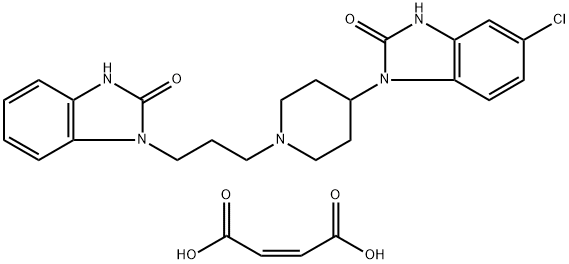
Domperidone maleate
- Product NameDomperidone maleate
- CAS99497-03-7
- CBNumberCB9247961
- MFC26H28ClN5O6
- MW541.99
- EINECS801-827-7
- MDL NumberMFCD07370074
- MOL File99497-03-7.mol
- MSDS FileSDS
Chemical Properties
| storage temp. | Hygroscopic, -20°C Freezer, Under inert atmosphere |
| solubility | Very slightly soluble in water, sparingly soluble in dimethylformamide, slightly soluble in methanol, very slightly soluble in ethanol (96 per cent). |
| form | Solid |
| color | White to Off-White |
| FDA UNII | 899U5WF46A |
Domperidone maleate Price
| Product number | Packaging | Price | Product description | Buy |
|---|---|---|---|---|
| TRC D531115 | 5mg | $8250 | Domperidone maleate |
Buy |
| American Custom Chemicals Corporation API0007069 | 100MG | $885.31 | DOMPERIDONE MALEATE 95.00% |
Buy |
| AK Scientific S484 | 5mg | $39 | Domperidone maleate |
Buy |
| AK Scientific S484 | 25mg | $88 | Domperidone maleate |
Buy |
| AK Scientific S484 | 100mg | $195 | Domperidone maleate |
Buy |
Domperidone maleate Chemical Properties,Usage,Production
Description
Domperidone maleate is a specific blocker of dopamine receptors. It speeds gastrointestinal peristalsis, causes prolactin release, and is used as antiemetic and tool in the study of dopaminergic mechanisms.Chemical Properties
Domperidone maleate occurs as a white or almost white powder that exhibits polymorphism. It is very slightly soluble in water or alcohol.Uses
Domperidone maleate (CAS# 99497-03-7); a form of Domperidone (D531100), a novel peripheral dopamine receptor antagonist that does not cross the blood-brain barrier; anti-emetic. Domperidone(Motilium) is a dopamine blocker and an antidopaminergic reagent.Preparation
Domperidone was synthesized at Janssen Pharmaceutica in 1974 following their research on antipsychotic drugs. The present invention relates to synthesis of domperidone maleate. O-diaminobenzene is first cyclized and halogenated to form the first benzimidazolone intermediate; 1-carbethoxy-4-amino piperidine is halogenated, reduced, cyclized and hydrolyzed to form the second benzimidazolone intermediate; the two benzimidazolone intermediates are reacted to produce domperidone; and domperidone is finally reacted with maleic aicd to produce domperidone maleate.https://patents.google.com/patent/CN1810805A/en
Indications
Domperidone may be useful for treatment of fescue toxicosis in pregnant mares or as a prokinetic or antiemetic agent in small animals. It has more effect on conditions with delayed gastric emptying than other GI hypomotility conditions. Via its effects on prolactin, domperidone may also be used to stimulate milk production in horses and small animals. Domperidone has been shown to increase plasma ACTH in horses with equine pituitary pars intermedia dysfunction (Equine Cushing’s) and may be useful in helping diagnose this condition.Side effects
Because plasma prolactin levels may be increased, galactorrhea or gynecomastia may result. Injectable products (now withdrawn) have been associated with arrhythmias in human patients with heart disease or hypokalemia. Rarely, somnolence or dystonic reac- tions have occurred in people.Preparation Products And Raw materials
Domperidone maleate Supplier
Global(80)Suppliers
| Supplier | Tel | Country | ProdList | Advantage | |
|---|---|---|---|---|---|
| +86-0371-55170693 +86-19937530512 |
info@tianfuchem.com | China | 21630 | 55 | |
| +undefined-21-51877795 | ivan@atkchemical.com | China | 33024 | 60 | |
| +86-0371-86658258 +8613203830695 |
sales@coreychem.com | China | 29861 | 58 | |
| 18905173768 | sales@dolonchem.com | CHINA | 2972 | 58 | |
| +8618523575427 | sales@conier.com | China | 49732 | 58 | |
| +86-0519-85551759 +8613506123987 |
marketing1@neostarunited.com | China | 8831 | 58 | |
| +86-15850508050 +86-15850508050 |
sean.lv@synzest.com | China | 323 | 58 | |
| 0082-42-721-7177 | michael@sinopro.co.kr | South Korea | 297 | 58 | |
| +86-0571-85134551 | sales@afinechem.com | China | 15350 | 58 | |
| +8615056975894 | shawn@hirisunpharm.com | CHINA | 9911 | 58 |
99497-03-7, Domperidone maleateRelated Search
PROMPT×
PROMPT
The What'sApp is temporarily not supported in mainland China
The What'sApp is temporarily not supported in mainland China
Cancel
Determine
